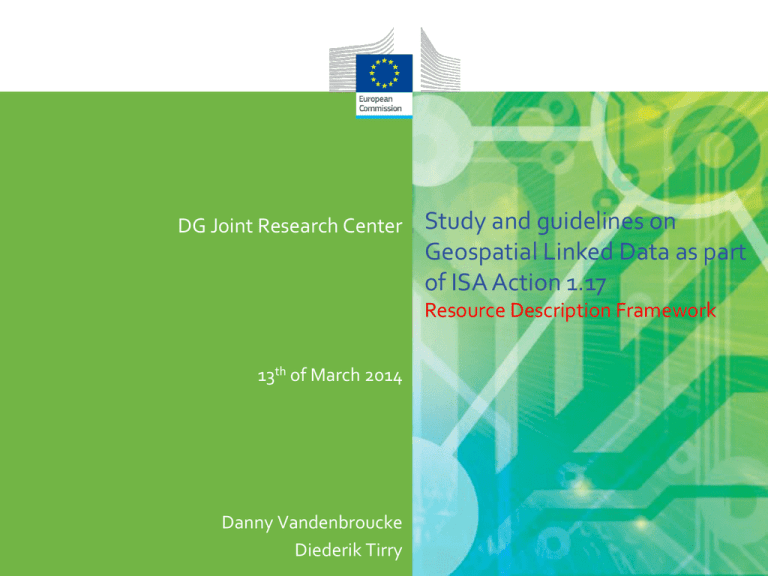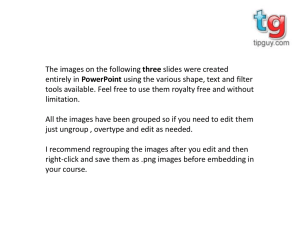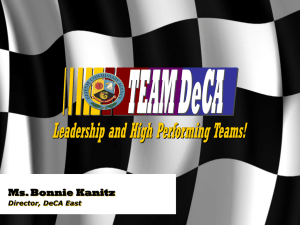WP2 RDF 0.6 - Joinup
advertisement

DG Joint Research Center Study and guidelines on Geospatial Linked Data as part of ISA Action 1.17 Resource Description Framework 13th of March 2014 Danny Vandenbroucke Diederik Tirry Agenda Click to edit Master title style 1 Introduction 2 Context 3 Literature study results 4 Sharing your experience – Issues/Challenges? 5 Next steps - Experiments 2 Introduction Today’s webinar 1. Setting the scene 2. Developing proposals Click toWeedit Master style will provide an outline title of the study and our work so far. This webinar is also an opportunity to provide feedback and to exchange experiences: where could INSPIRE RDF be used in e-government? WEBINAR II Guidelines on methodologies 3. Refinement & recommendations METHODOLOGIES Presentation of the first version of the guidelines for a common RDF Vocabulary for INSPIRE data and an approach to PID governance: opportunities for communityled improvements and next steps towards an official INSPIRE encoding. Resource Description Framework (RDF) 3 Agenda Click to edit Master title style 1 Introduction 2 Context 3 Literature study results 4 Sharing your experience – Issues/Challenges? 5 Next steps - Experiments 4 Context This study has been prepared in the context of the Interoperability for European PublicClick to Administrations (ISA) Programme and, in particular A Reusable INSPIRE Reference Platform (ARE3NA, ISA Action 1.17) This study should provide: edit Master title style Connecting Geospatial Data 1. Shared evidence about the current status in Europe of linked (geospatial) data related to INSPIRE. 2. An initial common/agreed methodology and guidelines towards RDF encodings for INSPIRE 3. Recommendations for how location PIDs could be governed for INSPIRE and other relevant activities. 5 Context 12/12 INSPIRE to edit Interoperability of geospatial data sets Click and services through harmonised data models and encodings for the exchange of data related to one of the 34 spatial data themes 1. 2. Master title style Data models using UML at conceptual level Encoding using GML based on encoding rules Several European project and national initiatives using publishing geospatial data as Linked Data Using the Resource Description Framework (RDF) However No agreed rules or guidelines on how to create such RDF vocabularies from the UML models 6 Agenda Click to edit Master title style 1 Introduction 2 Context 3 Literature study results 4 Sharing your experience – Issues/Challenges? 5 Next steps - Experiments 7 Current State and State of the Art Literature selection and review approach Compile and examine relevant, existingClick studiesto • edit Master title style External publications from presentations, technical reports, papers and books (see list) Describe different projects/initiatives at the European, national and sub-national levels, in the form of an overview table, including the approach followed • Most of the literature is related to (pilot) projects that took/are taking place in some Member States, among others The Netherlands, UK, Germany, Spain, Italy and Belgium or in European projects such as GeoKnow A selection of different projects/initiatives will be analyzed in more detail based upon agreed criteria • The focus for this part of the analysis will be on the technical aspects of the transformation of UML models into RDF The literature analysis is currently ongoing • The literature overview for RDF/UML is presented in the table below 8 Literature study results Author(s) Date Folmer, E., Reuvers, M., & 2013 Wilko, Q. Hart, G., & Dolbear, C. 2013 Heath, T., Hausenblas, M., Bizer, C., Cyganiak, R., & 2008 Hartig, O. Jentzsch, A. 2011 W3C 2013 Folmer, E. 2013 Farazi, F. et al. 2012 Lopez-Pellicer, F.J., Florczyk, A.J., Nogueras-Iso, J., Muro2011 Medrano, P.R. & ZarazagaSoria, F.J. Schade, S. & Lutz, M. Tschirner, S., Scherp, A. & Staab, S. Vanbockryck, J. & Robbrecht, J. Beckers, V. & Tirry, D. De Keyzer, M., Loutas, N., Colas, C. & Goedertier, S. De Keyzer, M., Loutas, N. & Goedertier, S. Loutas, N., De Keyzer, M. & Goedertier, S. 2010 2011 2012 2013 2013 2013 2013 van den Brink, L., Janssen, 2013 P., Quak, W. Click to edit Master title style Title Type Pilot Linked Open Data Nederland (NL) B Linked Data: a Geographic Perspective How to Publish Linked Data on the Web B W Description Source: http://www.pilod.nl/doc/boek2.pdf Source: Boca Raton: CRC Press, Taylor & Francis Group Source: http://events.linkeddata.org/iswc2008tutorial/ LOD Cloud Diagram as of September 2011 W Linking Open Data - W3C SWEO Community Project. W Introductie tweede Linked Open Data Pilot PPT Trentino government linked open geodata: first results PPT Linked Open Data for INSPIRE: From 3 to 5 star geospatial data PPT Opportunities and Challenges for using Linked Data in INSPIRE Semantic access to INSPIRE: How to publish and query advanced GML data Start to Link, a practical POI approach P PPT Linked Open Data: Pilot Project of NGI-Belgium TM1.2. Introduction to Linked Data (en) R PPT TM1.3. Introduction to RDF & SPARQL (en) PPT TM2.3. Design & Manage Persistent URIs (en) PPT From geodata to linked data: Transformation from GML to RDF BC Automated P Source: http://en.wikipedia.org/wiki/File:LOD_Cloud_Diagram_as_of_September_2011.png Source: http://www.w3.org/wiki/SweoIG/TaskForces/CommunityProjects/LinkingOpenData Source: http://www.geonovum.nl/sites/default/files/Presentatie%200%20ErwinFolmerv4.pdf Source: http://inspire.jrc.ec.europa.eu/events/conferences/inspire_2012/presentations/14.p df Source: http://inspire.jrc.ec.europa.eu/events/conferences/inspire_2011/presentations/170. pdf Source: http://publications.jrc.ec.europa.eu/repository/handle/111111111/15247 Source: http://ceur-ws.org/Vol-798/paper7.pdf Source: http://www.poweredbyinspire.eu/documents/0503-linkeddatarobbrecht.pdf Source: currently internal (report waiting for approval) Source: https://joinup.ec.europa.eu/community/ods/document/tm12-introductionlinked-data-en Source: https://joinup.ec.europa.eu/community/ods/document/tm13-introductionrdf-sparql-en Source: https://joinup.ec.europa.eu/community/ods/document/tm23-designmanage-persistent-uris-en Source: http://www.pilod.nl/wiki/Boek/BrinkEtAl-GML2RDF 9 Literature study results Author(s) Type Description R Source: https://joinup.ec.europa.eu/community/semic/document/cookbooktranslating-data-models-rdf-schemas 2013 2013 Deliverable 2.2.1 Integration of External Geospatial Databases R Athanasiou, S. et al. 2013 Deliverable 2.3.1 Prototype of built in Geospatial Capabilities R Williams, H. et al. Ngonga, A., Sherif, M. & Hassan, M. Deliverable 3.1.1 Development of First Prototype for Spatially Interlinking Data Sets R 2013 Wauer, M., Both, A., Stadtler, C. & Isele, R. R 2013 Deliverable 6.1.2 Report on Customer Data Preparation Source: http://svn.aksw.org/projects/GeoKnow/Public/D6.1.2_Customer_data_prepa ration.pdf GeoKnow 2013 Source: http://geoknow.eu/t2-7.html OGC 2012 R S Abbas, S. & Ojo, A. 2013 P Source: EGOVIS/EDEM 2013: 196-210. DOI: 10.1007/978-3-642-401602_16 Kerry Taylor, K., Lefort, L., Squire, G., Walker, G., Woolf, A., Shu, Y., Ratcliffe, D., Cox, S., Haller, A. Tsinaraki, C., Stavrakantonakis, I. & Christodoulakis, S. Date 2013 Title Click to edit Master title style Cookbook for translating Data Models to RDF Schemas Core Location Pilot - Interconnecting Belgian Address Data Archer, P., Loutas, N. & Goedertier, S. Colas, C., Goedertier, S., Kourtidis, S, Loutas, N. & Rubino, F. and Transformation for Linked Data Usage Task 2.7: Exposing INSPIRE data as Linked Data. GeoSPARQL - A Geographic Query Language for RDF Data Towards a Linked Geospatial Data Infrastructure. Developing Ontologies for Linked Geospatial Data R Source: http://svn.aksw.org/projects/GeoKnow/Public/D2.2.1_Integration_of_Geospa tial_Databases.pdf Source: http://svn.aksw.org/projects/GeoKnow/Public/D2.3.1_Prototype_of_Builtin_Geospatial_Capabilities.pdf Source: http://svn.aksw.org/projects/GeoKnow/Public/D3.1.1.Development_of_First_ Prototype_for_Spatially.pdf Source: http://www.opengeospatial.org/standards/geosparql P 2014 2007 Source: https://joinup.ec.europa.eu/asset/core_location/document/corelocation-pilot-interconnecting-belgian-address-data http://www.w3.org/2014/03/lgd/papers/lgd14_submission_41.pdf XS2OWL: Representation of XML Schemas in OWL syntax W http://www.music.tuc.gr/projects/sw/xs2owl/ 10 Literature study results INSPIRE community • • • • • Click to edit Master title style Linked Data community Tschirner, S., Scherp, A. & Staab, S. Semantic access to INSPIRE: How to publish and query advanced GML data van den Brink, L., Janssen, P. & Quak, W. - Linking spatial data: automated conversion of geo-information models and GML data to RDF Hobona, G., Brackin, R. – OGC OWS-8 Cross Community Interoperability (CCI) Semantic Mediation Engineering Report ISO/TC 211 – DIS-19150-2 - Ontology Part 2: Rules for developing ontologies in the Web Ontology Language (OWL) GeoKnow - Task 2.7: Exposing INSPIRE data as Linked Data (and related work) • • • • • Archer, P., Loutas, N. & Goedertier, S. Cookbook for translating Data Models to RDF Schemas Colas, C., Goedertier, S., Kourtidis, S, Loutas, N. & Rubino, F. - Core Location Pilot - Interconnecting Belgian Address Data Hyland, B., Atemezing, G. & VillazónTerrazas, B. - Best Practices for Publishing Linked Data ISA Programme – Action 1.1 - Deliverable 3.1 - Process and Methodology for Developing Core Vocabularies … 11 Literature If there is anything relevant missing from our list, please contact us: are3na@jrc.ec.europa.eu Click to edit Master title style The list will be provided together with this current presentation. 12 Literature study results Example of project on transformation: Geonovum & TU Delft Click to edit Master title style (Linda van den Brink, Paul Janssen & Wilko Quak) 1. Transforming GML into RDFS/OWL (automated using XSLT) 2. Transforming UML into RDFS/OWL (annotating the UML model) Motivation for the work • Currently service based dissemination of GML structured data • Semantics for predefined domains and clear use cases, controllable • Not flexible in view of new/revised concepts and relations • Transformation needed from local sources to INSPIRE data specs • The use of RDF and GeoSPARQL might be complementary • RDF transformation can/should be standardized 13 Literature study results UML data model (semantics) Issues/challenges for the GML to edit Master title style Click mapping as defined in ISO Application Schema ISO 19150 • • RDFS/OWL (ontologies) RDF • Closed world of UML versus open world of OWL Connection of concepts in UML and related concepts in vocabularies Modeling conventions and restrictions in UML Questions tackled in the research and experiments • • • Is it possible to describe a generic transformation from GML to RDF without knowledge about the underlying model? How should geometry be encoded in RDF? How to transform (automatically) the UML model into RDFS/OWL and can it be integrated with other ontologies on the web 14 Literature study results The experiment - IMRO Click to edit Master title style • Transformation of GML data to RDFS/OWL (automatically) using GML2RDF • Elements such as names and descriptions are mapped • Objects, also nested features, data types and properties are mapped • Point and surface features transformed to a WKT serialization • Transformation of UML to RDFS/OWL (semi-automatically) using ShapeChange • Tackle UML anomalies Other • Open-world oriented ontology Registries • Modifications ShapeChange code lists • Open issues services Application schema • Attributes • Classes metadata • Generation of an OWL vocabulary from GML application schema and UML model • Improved mapping from UML to OWL by adding information (annotation) Geonovum Experiments 15 Agenda Click to edit Master title style 1 Introduction 2 Context 3 Literature study results 4 Sharing your experience – Issues/Challenges? 5 Next steps - Experiments 16 Sharing your experience – Issues/Challenges? Sharing your experience Issues/Challenges? 12/12 • From the literature review (so far) andto from theMaster discussions in the Click edit title style London workshop several issues can be raised ... 1. It seems that there are too many semantics in UML stereotypes that are not amenable to a generic UML to OWL toolset (Taylor) • • 2. Potentially loss of much of the intrinsic OWL capabilities Hampering the interoperability with other RDF datasets For the transformation of domain models, start over again from scratch for developing an OWL model? Rules for generation of OWL and the work in ISO/TC 211 • • • Rule-based conversion without harmonization with existing ontologies Relating it to other OWL ontologies can be done by using RDFS/OWL mechanisms Other set of rules exist (e.g. in ShapeChange) Do we need to go for a flat rule-based conversion or not? 18 Sharing your experience Issues/Challenges? 12/12 • From the literature review (so far) andto from theMaster discussions in the Click edit title style London workshop several issues can be raised ... 3. Standards for geometry in RDF • Which standards to use? Debate during the London workshop: GeoSPARQL • • In the Dutch experiments GeoSPARQL was used with the WKT serialization • • 4. Which alternative? Revise GeoSPARQL ? Only Simple Feature Geometry and because WKT is compact Many vocabularies and extensions exist Other issues ? What are the key public service and policy areas where INSPIRE-related RDF can be (re)-used in e-government? LinkedGeoData Basic Geo GeoRSS GeoOWL GeoSPARQL Core Location NeoGeo ... 19 Agenda Click to edit Master title style 1 Introduction 2 Context 3 Literature study results 4 Sharing your experience – Issues/Challenges? 5 Next steps - Experiments 20 Next steps - Experiments Next steps - Experiments 12/12 In order to have a common methodology theMaster experiments Click to for edit titlesome style questions have to be answered A first series of questions / ideas based on the elements of Generic Conceptual Model 1. 2. 3. 4. 5. 6. How do you transform the general Feature model? What are the rules used for transforming spatial object types, attributes (spatial, temporal, locational, metadata, thematic), associations, constraints? Which related concepts from existing ontologies can be re-used? Are there any domain independent core vocabularies such as NASA’s sweet ontology, UCUM that could be used for units, dimensions… Which data types will be used for common data types (dates, integers, strings, etc…) How can target classes be identified in UML? How closed or open should the final OWL model be? 22 Next steps - Experiments 12/12 In order to have a common methodology theMaster experiments Click to for edit titlesome style questions have to be answered A first series of questions / ideas based on the elements of Generic Conceptual Model 7. 8. 9. 10. 11. 12. 13. 14. How to include links to application schema’s, INSPIRE feature concept dictionary, themes, code lists in the OWL schema? How to encode geometry? How to encode raster data? Should a distinction be made between enumerations and code lists? Is there a need to distinguish between different types of code lists (extensible vs nonextensible) How to deal with versioning and lifecycle information in OWL? How to deal with the concept of voidability? How to identify CRS? (now it is part of the geometry literal in GeoSPARQL) How to identify temporal reference systems? … 23 Literature If there is anything relevant missing from our first list of issues/questions to be tackled please say so Click to edit Master title style What are the priorities? contact us: are3na@jrc.ec.europa.eu 24 Next steps Click to edit Master title style 1. Highlights Follow us on Joinup. We will provide the highlights of this webinar 2. Refinement WEBINAR II: Guidelines & methodologies 5 & 6 May 2014 AND…. At any time, your feedback is very appreciated. 25 Next steps Click to edit Master title style Thank you for your participation! Join the collaborative platforms in other areas of Open Source & Semantic Interoperability on https://joinup.ec.europa.eu/ Connecting Geospatial Data 26



